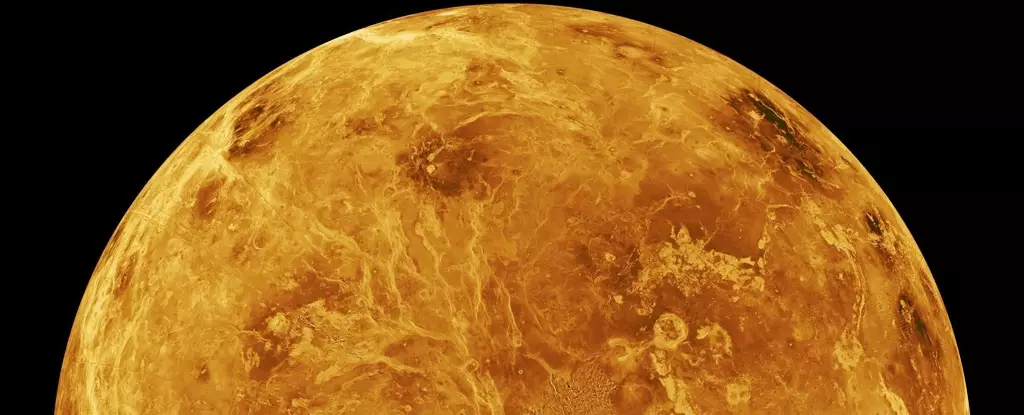In the primordial era of our Solar System, violent impacts were a common occurrence. As the planets formed, their surfaces were bombarded by numerous celestial bodies, resulting in a landscape marked by craters and basins. Among the rocky planets, Mercury, Mars, and the Moon still bear the scars from this chaotic period. Earth, despite its dynamic geological processes that tend to erase much of its history, also shows traces of giant impacts. Yet, when it comes to Venus, the situation appears puzzling. This planet, often shrouded in mystery due to its inhospitable environment, exhibits a seemingly contradictory trait: while its surface displays preserved impact craters, there is a shocking absence of craters larger than 300 kilometers in diameter. This raises questions about our understanding of Venus’s early environment and geological history.
Scientists have recently uncovered evidence that could reinterpret the history of impact craters on Venus, specifically through a geological feature known as tessera terrain. This anomalous terrain, consisting of intricate concentric rings, spans approximately 1,500 kilometers across and was long thought to contain no significant impact structures. However, with fresh analysis, researchers propose that the Haastte-Baad Tessera was indeed formed by two successive giant impacts on a planet that was markedly different from the Venus we observe today: a world with a thin crust and a molten interior, existing over 3.5 billion years ago.
Geologist Vicki Hansen from the Planetary Science Institute emphasizes the potential significance of this discovery. “If this is really an impact structure, it would be Venus’s oldest and largest, providing invaluable insights into the planet’s history and the processes involved in early planetary formation,” she states. This suggests that not all impacts leave behind conventional craters; rather, they can create unique geological formations that challenge our preconceived notions of planetary geology.
By employing advanced modeling techniques, Hansen and her colleagues investigated how such a massive and complex structure could form. They surmised that the Haastte-Baad Tessera originated from two back-to-back impacts. As these colossal celestial objects collided with the planet, they breached the thin 10-kilometer crust, causing molten material from the mantle to surge towards the surface and result in the distinctive tessera terrain.
This concept finds parallels elsewhere in the Solar System—in particular, with structures like Valhalla on Jupiter’s moon Callisto, which is the largest known multi-ring impact formation. In both cases, the impacts occurred while the planets had more molten interiors, enabling the surrounding crust to deform dramatically upon impact. However, Haastte-Baad presents a unique challenge because it does not sit atop a plateau, contrary to some formations found elsewhere.
The significance of the discovery goes beyond mere size. One of the profound aspects of impact formation is understanding the nature of both the impacting body—referred to as a bolide—and the target planet’s characteristics. The intricacies of how the bolide interacts with the planet reveal much about a world’s geological history. By studying these interactions, scientists can glean insights about the evolution of a planet after such cataclysmic events.
Hansen’s analysis introduces the concept of “residuum,” a solid material that remains after partial melting occurs in response to such impacts. Intriguingly, this residuum is both stronger and less dense compared to the surrounding mantle, akin to an air mattress floating beneath a pool of lava. This buoyancy could potentially elevate the tessera terrain as the molten lava spreads and cools, leading to the formation of the features we observe today.
Traditionally, researchers have sought huge craters as tell-tale signs of impact events. However, as now evidenced on Venus, the expectation of large, distinct depressions can be misleading. The surface of Venus, characterized by low-lying tessera terrain, challenges long-standing assumptions about impact geology. As Hansen poignantly notes, “Who would have thought flat low-lying tessera terrain is what an impact crater could look like on Venus?”
Several planetary geologists may have overlooked this distinctive mechanism in planetary geology, focusing instead on surfaces exhibiting the expected characteristics found on Earth and the Moon. The findings on Venus suggest a richer tapestry of geological history that could redefine our understanding of how impact craters vary among planetary bodies.
The implications of this new finding have far-reaching consequences for both planetary science and our understanding of Venus itself. By reexamining the early conditions that shaped this enigmatic planet, scientists can formulate more accurate models of planetary formation and evolution. The quest to understand impact craters and their roles in shaping planetary surfaces will undoubtedly continue, illuminating not only the mysteries of Venus but also those of other celestial bodies in our Solar System and beyond. Thus, discoveries like the Haastte-Baad Tessera serve as essential stepping stones toward a more nuanced understanding of planetary dynamics in our ever-evolving universe.


Leave a Reply